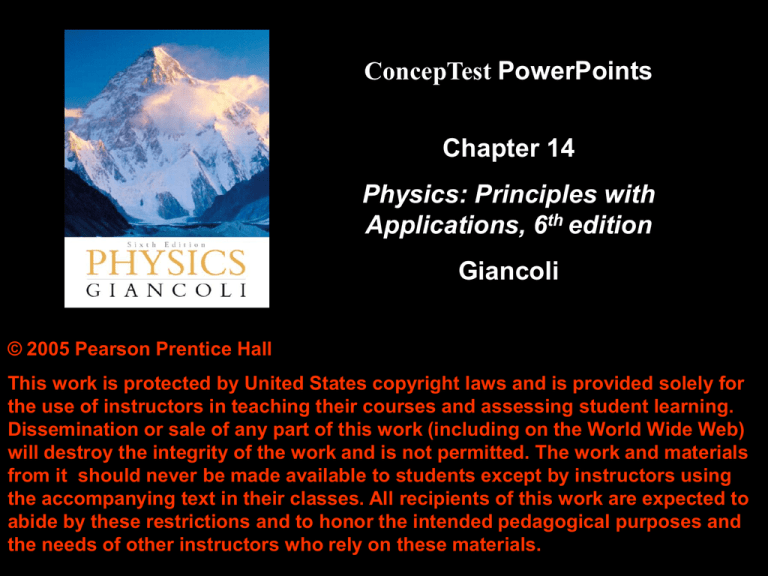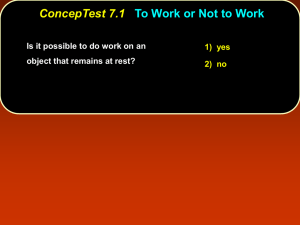
ConcepTest PowerPoints
Chapter 14
Physics: Principles with
Applications, 6th edition
Giancoli
© 2005 Pearson Prentice Hall
This work is protected by United States copyright laws and is provided solely for
the use of instructors in teaching their courses and assessing student learning.
Dissemination or sale of any part of this work (including on the World Wide Web)
will destroy the integrity of the work and is not permitted. The work and materials
from it should never be made available to students except by instructors using
the accompanying text in their classes. All recipients of this work are expected to
abide by these restrictions and to honor the intended pedagogical purposes and
the needs of other instructors who rely on these materials.
ConcepTest 14.1a
Two objects are made of
the same material, but have
different masses and
temperatures. If the
objects are brought into
thermal contact, which one
will have the greater
temperature change?
Thermal Contact I
1) the one with the higher initial temperature
2) the one with the lower initial temperature
3) the one with the greater mass
4) the one with the smaller mass
5) the one with the higher specific heat
ConcepTest 14.1a
Two objects are made of
the same material, but have
different masses and
temperatures. If the
objects are brought into
thermal contact, which one
will have the greater
temperature change?
Thermal Contact I
1) the one with the higher initial temperature
2) the one with the lower initial temperature
3) the one with the greater mass
4) the one with the smaller mass
5) the one with the higher specific heat
Since the objects are made of the same material, the only difference
between them is their mass. Clearly, the object with less mass will be
much easier to change temperature since there is not much material
there (compared to the more massive object).
ConcepTest 14.1b
Two different objects
receive the same amount
of heat. Which of the
following choices is NOT
a reason why the objects
may have different
temperature changes?
Thermal Contact II
1) they have different initial temperatures
2) they have different masses
3) they have different specific heats
ConcepTest 14.1b
Two different objects
receive the same amount
of heat. Which of the
following choices is NOT
a reason why the objects
may have different
temperature changes?
Thermal Contact II
1) they have different initial temperatures
2) they have different masses
3) they have different specific heats
Since Q = m c DT and the objects received the same amount of
heat, the only other factors are the masses and the specific heats.
While the initial temperature is certainly relevant for finding the
final temperature, it does not have any effect on the temperature
change DT.
ConcepTest 14.2
Two Liquids
Two equal-mass liquids, initially at the
same temperature, are heated for the same
1) the cooler one
time over the same stove. You measure
2) the hotter one
the temperatures and find that one liquid
has a higher temperature than the other.
Which liquid has a higher specific heat?
3) both the same
ConcepTest 14.2
Two Liquids
Two equal-mass liquids, initially at the
same temperature, are heated for the same
1) the cooler one
time over the same stove. You measure
2) the hotter one
the temperatures and find that one liquid
has a higher temperature than the other.
3) both the same
Which liquid has a higher specific heat?
Both liquids had the same increase in internal energy,
because the same heat was added.
But the cooler liquid
had a lower temperature change.
Since Q = mcDT, if Q and m are both the same and DT is
smaller, then c (specific heat) must be bigger.
ConcepTest 14.3a
The specific heat of concrete is
greater than that of soil. A baseball
field (with real soil) and the
surrounding parking lot are warmed
up during a sunny day. Which would
you expect to cool off faster in the
evening when the sun goes down?
Night on the Field
1) the concrete parking lot
2) the baseball field
3) both cool off equally fast
ConcepTest 14.3a
The specific heat of concrete is
greater than that of soil. A baseball
field (with real soil) and the
surrounding parking lot are warmed
up during a sunny day. Which would
you expect to cool off faster in the
evening when the sun goes down?
Night on the Field
1) the concrete parking lot
2) the baseball field
3) both cool off equally fast
The baseball field, with the lower specific heat, will change
temperature more readily, so it will cool off faster. The high specific
heat of concrete allows it to “retain heat” better and so it will not cool
off so quickly – it has a higher “thermal inertia.”
ConcepTest 14.3b
Night on the Beach
Water has a higher specific
1) from the ocean to the beach
heat than sand. Therefore,
2) from the beach to the ocean
on the beach at night,
breezes would blow:
3) either way, makes no difference
ConcepTest 14.3b
Water has a higher specific
1) from the ocean to the beach
heat than sand. Therefore,
2) from the beach to the ocean
on the beach at night,
breezes would blow:
Night on the Beach
3) either way, makes no difference
Daytime
sun heats both the beach and the water
» beach heats up faster
» warmer air above beach rises
» cooler air from ocean moves in underneath
» breeze blows ocean land
csand < cwater
Nighttime
sun has gone to sleep
» beach cools down faster
» warmer air is now above the ocean
» cooler air from beach moves out to the ocean
» breeze blows land ocean
ConcepTest 14.4
Calorimetry
1) 0 oC
1 kg of water at 100 oC is poured into a
2) 20 oC
bucket that contains 4 kg of water at 0
3) 50 oC
oC.
4) 80 oC
Find the equilibrium temperature
(neglect the influence of the bucket).
5) 100 oC
ConcepTest 14.4
Calorimetry
1) 0 oC
1 kg of water at 100 oC is poured into a
2) 20 oC
bucket that contains 4 kg of water at 0
3) 50 oC
oC.
4) 80 oC
Find the equilibrium temperature
(neglect the influence of the bucket).
Since the cold water mass is greater, it will
have a smaller temperature change!
5) 100 oC
Q1 = Q2
The masses of cold/hot have a ratio of 4:1,
m1cDT1 = m2cDT2
so the temperature change must have a
DT1 / DT2 = m2 / m1
ratio of 1:4 (cold/hot).
ConcepTest 14.5
A 1 kg block of silver (c = 234 J/kg
0C
) is heated to 100 0C, then
More Calorimetry
1) 0oC
2) between 0oC and 50oC
dunked in a tub of 1 kg of water (c
3) 50oC
= 4186 J/kg 0C ) at 0 0C. What is the
4) between 50oC and 100oC
final equilibrium temperature?
5) 100oC
ConcepTest 14.5
A 1 kg block of silver (c = 234 J/kg
0C
) is heated to 100 0C, then
More Calorimetry
1) 0oC
2) between 0oC and 50oC
dunked in a tub of 1 kg of water (c
3) 50oC
= 4186 J/kg 0C ) at 0 0C. What is the
4) between 50oC and 100oC
final equilibrium temperature?
5) 100oC
Since cwater >> csilver it takes more heat to
change the temperature of the water than it
Q1 = Q2
does to change the temperature of the silver.
mc1DT1 = mc2DT2
In other words, it is much “harder” to heat the
DT1 / DT2 = c2 / c1
water!! Thus, the final temperature has to be
closer to the initial temperature of the water.
ConcepTest 14.6
If you add some heat to a substance,
is it possible for the temperature of
the substance to remain unchanged?
Adding Heat
1) yes
2) no
ConcepTest 14.6
If you add some heat to a substance,
is it possible for the temperature of
the substance to remain unchanged?
Adding Heat
1) yes
2) no
Yes, it is indeed possible for the temperature to stay the same. This is
precisely what occurs during a phase change – the added heat goes
into changing the state of the substance (from solid to liquid or from
liquid to gas) and does not go into changing the temperature! Once
the phase change has been accomplished, then the temperature of the
substance will rise with more added heat.
Follow-up: Does that depend on the substance?
ConcepTest 14.7
Will potatoes cook faster if the
water is boiling faster?
Hot Potato
1) yes
2) no
ConcepTest 14.7
Will potatoes cook faster if the
water is boiling faster?
Hot Potato
1) yes
2) no
The water boils at 100 °C and remains at that temperature until all
of the water has been changed into steam. Only then will the
steam increase in temperature. Since the water stays at the same
temperature, regardless of how fast it is boiling, the potatoes will
not cook any faster.
Follow-up: How can you cook the potatoes faster?
ConcepTest 14.8
You put 1 kg of ice at 0oC
together with 1 kg of water at
50oC. What is the final
temperature?
LF = 80 cal/g
cwater = 1 cal/g oC
Water and Ice
1) 0oC
2) between 0oC and 50oC
3) 50oC
4) greater than 50oC
ConcepTest 14.8
You put 1 kg of ice at 0oC
together with 1 kg of water at
50oC. What is the final
temperature?
LF = 80 cal/g
cwater = 1 cal/g oC
Water and Ice
1) 0oC
2) between 0oC and 50oC
3) 50oC
4) greater than 50oC
How much heat is needed to melt the ice?
Q = m Lf = (1000g) (80 cal/g) = 80,000 cal
How much heat can the water deliver by cooling from 50oC to 0oC?
Q = cwater m DT = (1 cal/g oC) (1000g) (50oC) = 50,000 cal
Thus, there is not enough heat available to melt all the ice!!
Follow-up: How much more water at 50oC would you need?
ConcepTest 14.9
You put 1 kg of ice at 0oC
together with 1 kg of steam at
Ice and Steam
1) between 0oC and 50oC
100oC. What is the final
2) 50oC
temperature?
3) between 50oC and 100oC
LF = 80 cal/g, Lv = 540 cal/g
cwater = 1 cal/g oC
4) 100oC
5) greater than 100oC
ConcepTest 14.9
You put 1 kg of ice at 0oC
together with 1 kg of steam at
Ice and Steam
1) between 0oC and 50oC
100oC. What is the final
2) 50oC
temperature?
3) between 50oC and 100oC
LF = 80 cal/g, Lv = 540 cal/g
cwater = 1 cal/g oC
4) 100oC
5) greater than 100oC
How much heat is needed to melt the ice?
Q = m Lf = (1000g) (80 cal/g) = 80,000 cal
How much heat is needed to raise the water temperature to 100oC?
Q = cwater m DT = (1 cal/g oC)(1000g)(100oC) = 100,000 cal
But if all of the steam turns into water, that would release 540,000 cal.
Thus, some steam is left over, and the whole mixture stays at 100oC.
Follow-up: How much more ice would you need?
ConcepTest 14.10
You’re in Hot Water!
Which will cause more severe burns
to your skin: 100 °C water or 100 °C
steam?
1) water
2) steam
3) both the same
4) it depends...
ConcepTest 14.10
You’re in Hot Water!
Which will cause more severe burns
to your skin: 100 °C water or 100 °C
steam?
1) water
2) steam
3) both the same
4) it depends...
While the water is indeed hot, it releases only 1 cal/g of heat as it
cools. The steam, however, first has to undergo a phase change
into water and that process releases 540 cal/g, which is a very
large amount of heat. That immense release of heat is what
makes steam burns so dangerous.
ConcepTest 14.11
You step out of a swimming
pool on a hot day, where the
air temperature is 90° F. Where
will you feel cooler, in Phoenix
(dry) or in Philadelphia
(humid)?
Spring Break
1) equally cool in both places
2) Philadelphia
3) Phoenix
ConcepTest 14.11
You step out of a swimming
pool on a hot day, where the
air temperature is 90° F. Where
will you feel cooler, in Phoenix
(dry) or in Philadelphia
(humid)?
Spring Break
1) equally cool in both places
2) Philadelphia
3) Phoenix
In Phoenix, where the air is dry, more of the water will
evaporate from your skin. This is a phase change,
where the water must absorb the heat of vaporization,
which it takes from your skin. That is why you feel
cool as the water evaporates.
ConcepTest 14.12
Given your experience of
what feels colder when you
walk on it, which of the
surfaces would have the
highest thermal conductivity?
Heat Conduction
a)
b)
c)
d)
a rug
a steel surface
a concrete floor
has nothing to do with
thermal conductivity
ConcepTest 14.12
Given your experience of
what feels colder when you
walk on it, which of the
surfaces would have the
highest thermal conductivity?
Heat Conduction
a)
b)
c)
d)
a rug
a steel surface
a concrete floor
has nothing to do with
thermal conductivity
The heat flow rate is k A (T1-T2)/l. All things being
equal, bigger k leads to bigger heat loss.
From the book: Steel=40, Concrete=0.84,
Human tissue=0.2, Wool=0.04, in units of J/(s.m.C0).
ConcepTest 14.13
If the Sun’s surface
temperature falls to half the
current surface temperature,
by what factor will the
radiant energy reaching the
Earth change?
Radiation
a) increase by factor of 16
b) increase by factor of 4
c) it will remain the same
d) decrease by factor of 4
e) decrease by factor of 16
ConcepTest 14.13
If the Sun’s surface
temperature falls to half the
current surface temperature,
by what factor will the
radiant energy reaching the
Earth change?
Radiation
a) increase by factor of 16
b) increase by factor of 4
c) it will remain the same
d) decrease by factor of 4
e) decrease by factor of 16
Radiation energy is proportional to T4. So if temperature
is halved, radiation energy will decrease by a factor of 16.






